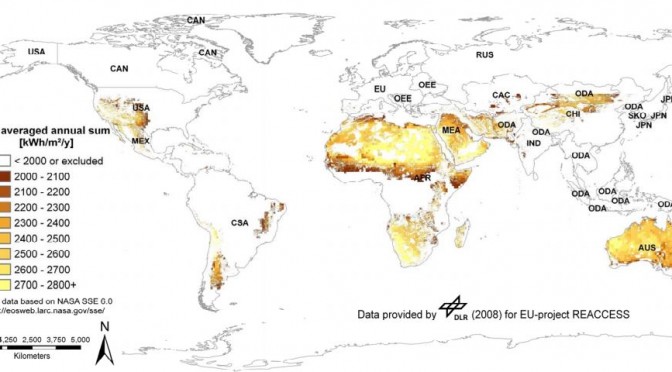Africa has the best potential for solar energy developments. The continent’s DNI as proof of this. Known as direct normal irradiation or Direct Solar Irradiance, the DNI is used to assess a region’s potential for generating energy through photovoltaics or concentrated solar power (CSP).
For a continent with the highest concentration of sunlight, one would expect Africa to be on the driving seat of Solar Power technology. But it’s the opposite.
SolarSpaces calculated how much open land in each region receives incoming solar energy of more than 2,000 kWh/m²/y, the result was stunning. Africa receives around 49 percent of the world’s solar energy, more than double of that of Australia—the second highest receiver. Ironically, the EU, with less than a fraction of Africa’s solar energy resource, is currently tapping more from the sun than Africa continent as a whole.
Not only does the US state of California have more solar power stations than the whole of Africa, its installed solar capacity is twice the total of all of Nigeria’s power generating capacity.
However, given the desperate need for electricity to drive development, some African countries are beginning to make more effort to tap this abundant natural resource. Last November, a US investment consortium, Motir Seaspire, signed an MoU with the Nigerian government to deliver 1,200MW of solar-powered electricity in the country by 2017. Rwanda, Uganda, Morocco, Kenya, Malawi, Ghana, and Ethiopia are among several other countries that have signed deals with new-energy firms for the development of solar power stations. While these efforts represent a good start, they barely scratch the surface.
According to SolarSpace, the world’s solar power has the potential to generate almost three million terawatt-hours per year (TWh/y), which is nearly 200 times the present world electricity consumption of 18,000 TWh/y. The annual electricity consumption of sub-Saharan Africa is less than 1000KWh, this is dismal compared to its solar power potential of up to 1.5 million TWh a year. So why is Africa not doing enough to tap the free sun? The common excuse is the cost. “While the costs of such systems are still high today, they can become a competitive option of electricity supply in the medium term, if an optimistic/realistic expansion of this technology — which can already be perceived today — takes place,” wrote SolarSpaces in its research report.
Africa’s efforts to produce electricity has been focused on hydroelectric and gas fired power plants, South Africa’s power generation is mainly sourced from coal. Unlike these energy sources, which are dependent on finite resources, Solar energy is renewable, sustainable and efficient. It is time for Africa to tap the sun, rather than hiding under it.
http://www.helioscsp.com/noticia.php?id_not=2915
termosolar, Concentrated Solar Power, Concentrating Solar Power, CSP, Concentrated Solar Thermal Power, solar power, solar energy, Africa,




